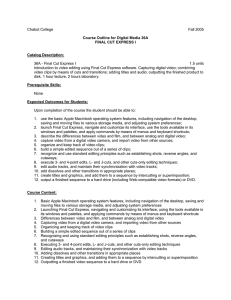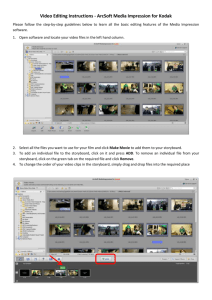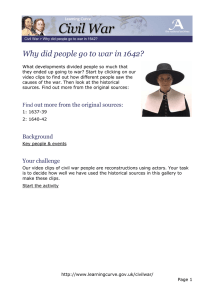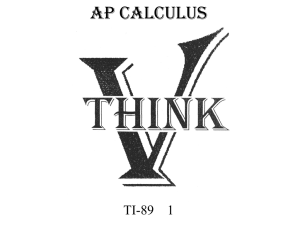Chabot College Fall 2007 36A - Final Cut I
advertisement
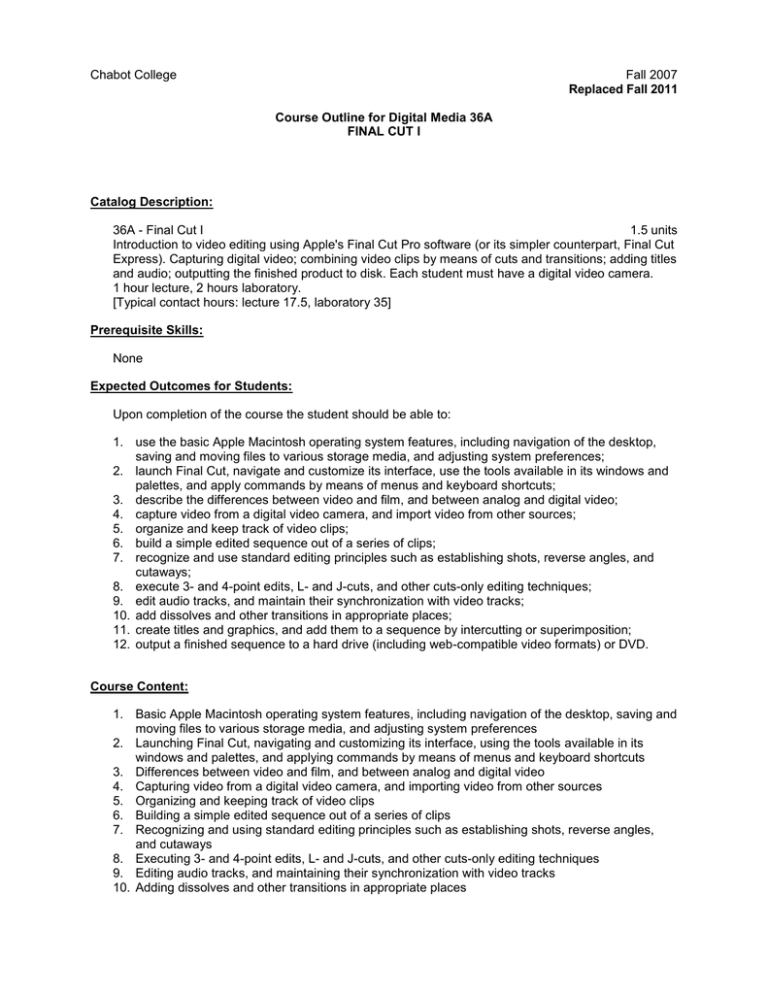
Chabot College Fall 2007 Replaced Fall 2011 Course Outline for Digital Media 36A FINAL CUT I Catalog Description: 36A - Final Cut I 1.5 units Introduction to video editing using Apple's Final Cut Pro software (or its simpler counterpart, Final Cut Express). Capturing digital video; combining video clips by means of cuts and transitions; adding titles and audio; outputting the finished product to disk. Each student must have a digital video camera. 1 hour lecture, 2 hours laboratory. [Typical contact hours: lecture 17.5, laboratory 35] Prerequisite Skills: None Expected Outcomes for Students: Upon completion of the course the student should be able to: 1. use the basic Apple Macintosh operating system features, including navigation of the desktop, saving and moving files to various storage media, and adjusting system preferences; 2. launch Final Cut, navigate and customize its interface, use the tools available in its windows and palettes, and apply commands by means of menus and keyboard shortcuts; 3. describe the differences between video and film, and between analog and digital video; 4. capture video from a digital video camera, and import video from other sources; 5. organize and keep track of video clips; 6. build a simple edited sequence out of a series of clips; 7. recognize and use standard editing principles such as establishing shots, reverse angles, and cutaways; 8. execute 3- and 4-point edits, L- and J-cuts, and other cuts-only editing techniques; 9. edit audio tracks, and maintain their synchronization with video tracks; 10. add dissolves and other transitions in appropriate places; 11. create titles and graphics, and add them to a sequence by intercutting or superimposition; 12. output a finished sequence to a hard drive (including web-compatible video formats) or DVD. Course Content: 1. Basic Apple Macintosh operating system features, including navigation of the desktop, saving and moving files to various storage media, and adjusting system preferences 2. Launching Final Cut, navigating and customizing its interface, using the tools available in its windows and palettes, and applying commands by means of menus and keyboard shortcuts 3. Differences between video and film, and between analog and digital video 4. Capturing video from a digital video camera, and importing video from other sources 5. Organizing and keeping track of video clips 6. Building a simple edited sequence out of a series of clips 7. Recognizing and using standard editing principles such as establishing shots, reverse angles, and cutaways 8. Executing 3- and 4-point edits, L- and J-cuts, and other cuts-only editing techniques 9. Editing audio tracks, and maintaining their synchronization with video tracks 10. Adding dissolves and other transitions in appropriate places Chabot College Course Outline for Digital Media 36A, page 2 Fall 2007 11. Creating titles and graphics, and adding them to a sequence by intercutting or superimposition 12. Outputting a finished video sequence to a hard drive or DVD Methods of Presentation: 1. Computer demonstrations 2. Video projection 3. Lecture with whiteboard Assignments and Methods of Evaluating Student Progress: 1. Typical Assignments a. Edit a simple narrative sequence b. Edit a TV news story c. Edit a suspenseful scene d. Edit an instructional or training sequence 2. Methods of Evaluating Student Progress a. Homework assignments b. Quizzes and exams, including a final exam Textbook(s) (Typical): Apple Pro Training Series: Final Cut Express 2, Diana Weynand, Peachpit Press (March 2004) Apple Pro Training Series: Final Cut Pro 5, Diana Weynand, Peachpit Press (August 5, 2005) Special Student Materials: Digital video camera with high-speed data-transfer port (such as Firewire or USB 2) MS:\CurriculumF2007\DM36A Revised: 4/25/06
